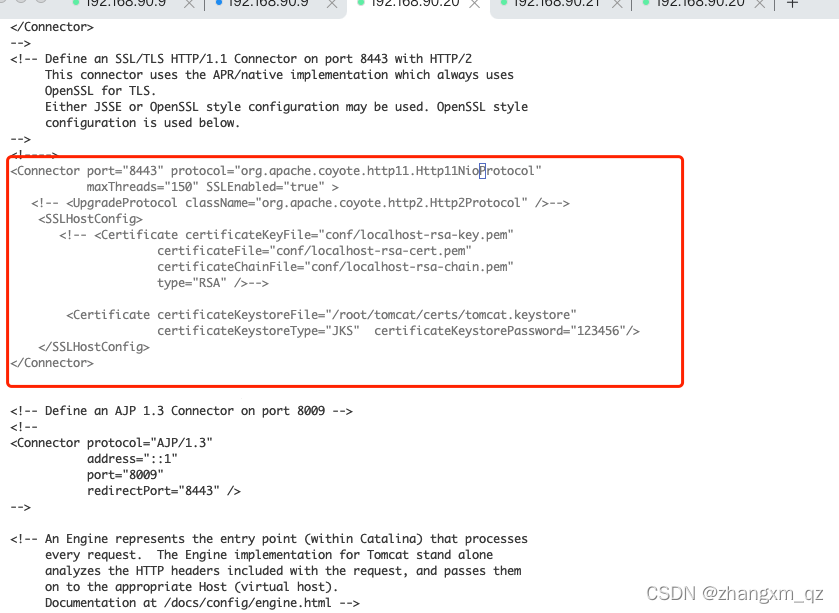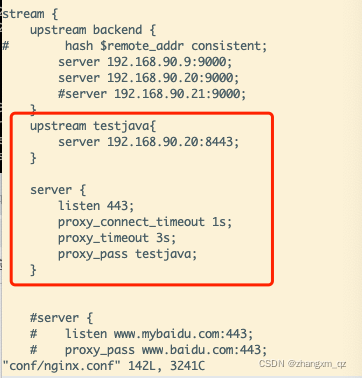文章目录
本文旨在测试 nginx对 http服务 https 服务 的代理方式。
部署测试 http服务
准备测试服务程序 gintest 并启动如下
[root@localhost ~]# sudo nohup ./gintest 9000 &
[1] 4229
[root@localhost ~]# nohup: 忽略输入并把输出追加到"nohup.out"
[root@localhost ~]#
[root@localhost ~]# curl http:localhost:9000
curl: (6) Could not resolve host: http:localhost; 未知的错误
[root@localhost ~]# curl http://localhost:9000
{"message":"测试程序,服务器ip:192.168.90.9,端口:9080"}[
nginx反向代理 http服务
安装 nginx 并修改配置文件 ,对 web服务进行代理如下
server {
listen 80;
server_name localhost;
#charset koi8-r;
#access_log logs/host.access.log main;
location / {
proxy_pass http://192.168.90.9:9000;
root html;
index index.html index.htm;
}
#error_page 404 /404.html;
# redirect server error pages to the static page /50x.html
#
error_page 500 502 503 504 /50x.html;
location = /50x.html {
root html;
}
启动 nginx 并访问,结果如下 代理成功

nginx 通过 https反向代理 http服务
使用 https 服务需要安装http_ssl_module 否则会报错 『ssl parameter requires ngx_http_ssl_module』
重新编译安装 nginx
nginx源码根目录执行如下命令 ,重新编译 ,输出目录保持不变
./configure --with-http_stub_status_module --with-http_ssl_module
make && make install 安装
成功后可以看到我们的 nginx 目录下已经安装了新版本的 nginx

配置 nginx
提前准备好一套证书和私钥, tls.crt tls.key
nginx http 模块配置中,增加如下配置
server {
listen 443 ssl;
server_name www.mytest.com;
ssl_certificate /root/tls.crt;
ssl_certificate_key /root/tls.key;
ssl_session_cache shared:SSL:1m;
ssl_session_timeout 5m;
ssl_ciphers HIGH:!aNULL:!MD5;
ssl_prefer_server_ciphers on;
location / {
proxy_pass http://192.168.90.9:9000;
root html;
index index.html index.htm;
}
}
重新加载 配置
[root@localhost conf]# ../sbin/nginx -s reload
访问测试
通过https访问应用成功,如下:

这种情况下需要将 应用的证书配置到nginx,如果 nginx代理了很多应用,每个应用证书不同,那么需要配置很多证书。
nginx提供了 stream 模块用于 tcp/udp 请求直接转发后台服务器处理,不用配置证书。如下
Nginx Stream模块负载均衡测试
准备测试用 https服务
准备一个 java https 服务
部署 tomcat及 web示例应用

生成tomcat 证书
[root@mysql tomcat]# keytool -genkey -v -alias tomcat -keyalg RSA -keystore /root/tomcat/certs/tomcat.keystore -validity 365
输入密钥库口令:
再次输入新口令:
您的名字与姓氏是什么?
[Unknown]: zhang
您的组织单位名称是什么?
[Unknown]: pcitc
您的组织名称是什么?
[Unknown]: ptitc
您所在的城市或区域名称是什么?
[Unknown]: bj
您所在的省/市/自治区名称是什么?
[Unknown]: bj
该单位的双字母国家/地区代码是什么?
[Unknown]: bj
CN=zhang, OU=pcitc, O=ptitc, L=bj, ST=bj, C=bj是否正确?
[否]: y
正在为以下对象生成 2,048 位RSA密钥对和自签名证书 (SHA256withRSA) (有效期为 365 天):
CN=zhang, OU=pcitc, O=ptitc, L=bj, ST=bj, C=bj
输入 <tomcat> 的密钥口令
(如果和密钥库口令相同, 按回车):
[正在存储/root/tomcat/certs/tomcat.keystore]
Warning:
JKS 密钥库使用专用格式。建议使用 "keytool -importkeystore -srckeystore /root/tomcat/certs/tomcat.keystore -destkeystore /root/tomcat/certs/tomcat.keystore -deststoretype pkcs12" 迁移到行业标准格式 PKCS12。
[root@mysql tomcat]# ll certs
总用量 4
-rw-r--r-- 1 root root 2201 3月 3 00:14 tomcat.keystore
配置 tomcat SSL 连接
tomcat 配置文件 server.xml中增加如下内容 :

https服务访问测试
通过 https 访问web服务成功
https://192.168.90.20:8443/testWeb/index.jsp

nginx stream 安装配置
nginx 安装 stream 模块
重新编译安装 nginx
./configure --with-stream
make && make install
配置 nginx stream
nginx.conf配置文件中增加 stream配置(和 http 模块并列)

访问测试
通过 nginx 443 端口可以在没有配置证书的情况下可以通过 https访问后台的应用。

负载均衡策略
该模块支持的负载均衡策略如下:
Round Robin 轮询– 默认情况下,NGINX 使用 Round Robin 算法对流量进行负载平衡,将其按顺序定调用上游组中的服务器。因为是默认方法,所以没有 round?robin 指令 不配置即为 轮询。
Least Connections 最少连接数:( least_conn) - NGINX 选择当前活动连接数较少的服务器。
Least Time ( least_time;仅适用于 NGINX Plus ) – 选择具有最低平均延迟和最少活动连接数的服务器。用于计算最低平均延迟的方法取决于 least_time 指令中包含以下哪些参数:
connect – 连接上游服务器的时间
first_byte – 接收第一个数据字节的时间
last_byte – 从服务器接收完整响应的时间
示例如下:
upstream stream_backend {
least_time first_byte;
server backend1.example.com:12345;
server backend2.example.com:12345;
server backend3.example.com:12346;
}
Hash ( hash) – NGINX 根据用户定义的header选择服务器,例如源 IP 地址 ( $remote_addr),如下:
upstream stream_backend {
hash $remote_addr;
server backend1.example.com:12345;
server backend2.example.com:12345;
server backend3.example.com:12346;
}
哈希负载平衡方法常用于保持会话。指定一个 consistent 选项 可以使用 ketama 一致性hash算法:
hash $remote_addr consistent;
默认采用轮询算法
nginx stream 中upstream 配置两个后台服务器如下:
upstream testjava{
server 192.168.90.20:8443;
server 192.168.90.21:8443;
}
server {
listen 443;
proxy_connect_timeout 1s;
proxy_timeout 3s;
proxy_pass testjava;
}
进行访问测试 两个后台服务器轮流被访问


一致性 hash 算法测试
nginx.conf stream 模块 中配置如下
upstream testjava{
hash $remote_addr consistent;
server 192.168.90.20:8443;
server 192.168.90.21:8443;
}
server {
listen 443;
proxy_connect_timeout 1s;
proxy_timeout 3s;
proxy_pass testjava;
}
多次访问都访问到同一个后台服务器,证明会话保持成功

参考文档:http://www.wjhsh.net/felixzh-p-8696552.html